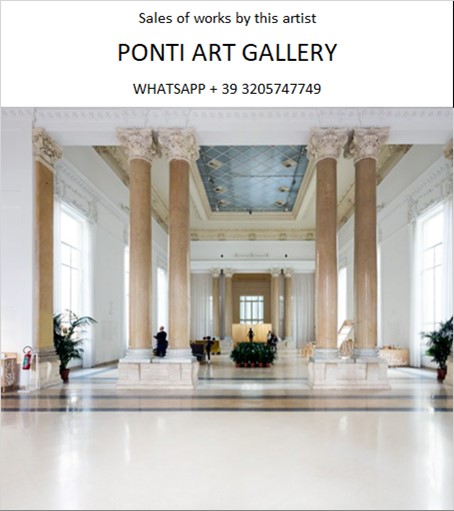Ponti Art Gallery is interested in buying and selling works
of art by this artist.

Aref El-Rayess Biography
Aref El Rayess, born on October 25, 1928, in Aley, Mount Lebanon, was a multifaceted Lebanese artist whose creative journey spanned over five decades, leaving an indelible mark on the landscape of modern Arab art. His oeuvre, characterized by its diversity and depth, encompassed painting, sculpture, etching, collage, and tapestry, reflecting a life rich in cultural and artistic exploration.
El Rayess's artistic inclinations surfaced early in his life, and by the age of eleven, he had already begun to paint. His initial foray into the art world was as a self-taught artist, and he held his first exhibition in 1948 at the American University of Beirut. This exhibition was supported by notable figures such as journalist Arlette Levy, artist Georges Cyr, art critic Victor Hakim, and the Head of the French Institute of Archaeology, Henry Seyrig.
The nomadic spirit of El Rayess led him to live in Africa for many years, where he traveled between Senegal and Paris. His time in Africa was not only a period of survival but also one of artistic relish as he painted scenes from his surroundings with fervor. In Paris, he further honed his skills by joining the studios of renowned artists such as Fernand Léger, André Lhote, Marcel Marceau, and Ossip Zadkine while studying at the Académie de la Grande Chaumière.
El Rayess's return to Lebanon in 1957 was brief, as he soon left for Florence in 1959 on a scholarship from the Italian government. He spent four productive years between Florence and Rome, where he continued his studies and exhibited his work. In 1963, he returned to Lebanon, a move that marked the beginning of a significant phase in his career.
In Lebanon, El Rayess played a pivotal role in the development of the local art scene. He co-founded the Institute of Fine Arts at the Lebanese University in 1963 and taught there from 1966 until 1980. His influence extended beyond teaching as he was elected chairman of the Lebanese Association of Artists and Sculptors, holding the position from 1969 to 1977.
El Rayess's work is a testament to his belief in the interconnectivity of the universe, man, and time. His art often revolved around themes of humanity, identity, and nature, and he was known for denouncing injustice, materialism, and the superficiality of nationalism in the Global South. His artistic talents and interest in political subject matter were evident from an early age, as demonstrated by a charcoal drawing he completed at seventeen, depicting the tragedy of Hiroshima's atomic bomb.
Throughout his career, El Rayess participated in numerous group shows, including the biennales of São Paulo and Baghdad, and held more than fifteen solo shows in Lebanon. His international exhibitions spanned galleries and museums in Rome, Florence, New York, Mexico, Paris, Damascus, Algeria, and Venezuela. He was also commissioned by the Lebanese government to design and execute a tapestry for the UNESCO center in Paris and to create sculptures representing Lebanon at the World Fair in New York.
El Rayess's contributions to art were recognized with several awards in Lebanon, including the Lebanese Ministry of National Education Award, the Unesco Prize for the Spring Salon, and multiple prizes from the Ministry of Public Works and the Sursock Museum.
In the 1980s, El Rayess's journey took him to the Kingdom of Saudi Arabia, where he lived for a time and was appointed as the Art Consultant for the city of Jeddah. He was commissioned to produce a number of monumental public sculptures, the most ambitious of which was a twenty-seven-meter-high aluminum sculpture of the stylized name of Allah that stands in Palestine Square in Jeddah.
El Rayess's legacy is a rich body of works that embrace expressive realism and symbolism while reaching into the realms of abstraction. His Sand Period, characterized by research and experimentation with Arabic calligraphy, blocks of shapes, surfaces of objects, light, and color, was a pivotal phase in his artistic journey. His work has had a significant influence on subsequent generations of artists, particularly through his teaching and his role as President of the Lebanese Association of Painters and Sculptors.
Aref El Rayess passed away on January 27, 2005, leaving behind a legacy that continues to inspire and influence the world of art. His work remains a powerful reflection of his era, capturing the zeitgeist and the specificities of the art scene and period in which he lived.
Aref El-Rayess Quotes and
Sales of Works
Ponti Art Gallery selects and deals with paintings by the
artist. Upon request, we provide free estimates and
evaluations, communicate prices, quotations, and current
market values.
If you are interested in BUYING or SELLING works by the
artist, contact us immediately.
If you wish to sell or receive an evaluation of the
works:
Send us a frontal photo of the painting, one of the back,
and one of the signature. Also, indicate the dimensions of
the work. Inform us about the purchase origin of the work
and any kind of available documentation (purchase
receipts, certificates of authenticity, publications). One
of our operators will respond to you on the same day. We
guarantee maximum confidentiality and extreme
professionalism.
If you wish to purchase works by the painter: Contact us
and let us know your request. We will inform you about the
available works. We also offer the possibility to
subscribe to our NEWSLETTER, through which you will be
informed at the beginning of each month about the latest
acquisitions of the art gallery.
You can send us pictures of the work:
